Building Contracts: Assessment Task 1 Solution and Analysis of Details
VerifiedAdded on 2022/10/10
|16
|3709
|54
Homework Assignment
AI Summary
This document presents a comprehensive solution to Building Contracts Assessment Task 1, addressing various aspects of construction projects. The solution covers topics such as subcontractor selection, material schedules, changes in drawings, call forward documents, final project costs, timber specifications, cost analysis, site document security, site security measures, and a list of relevant documents. It also includes answers to questions related to bills of quantities, project cost reduction, critical path establishment, operational energy, future project guidance, defects liability period, contract amendments, contingency sums, nominated subcontractors, slump tests, timber storage, lightweight construction, material selection criteria, liquidated damages, cost variance analysis, and project documentation. Furthermore, the document addresses aspects like soundproofing, slab on ground construction, and engineered floor framing systems, providing detailed answers to the questions presented in the assignment. This document is a valuable resource for students studying building contracts and construction management.
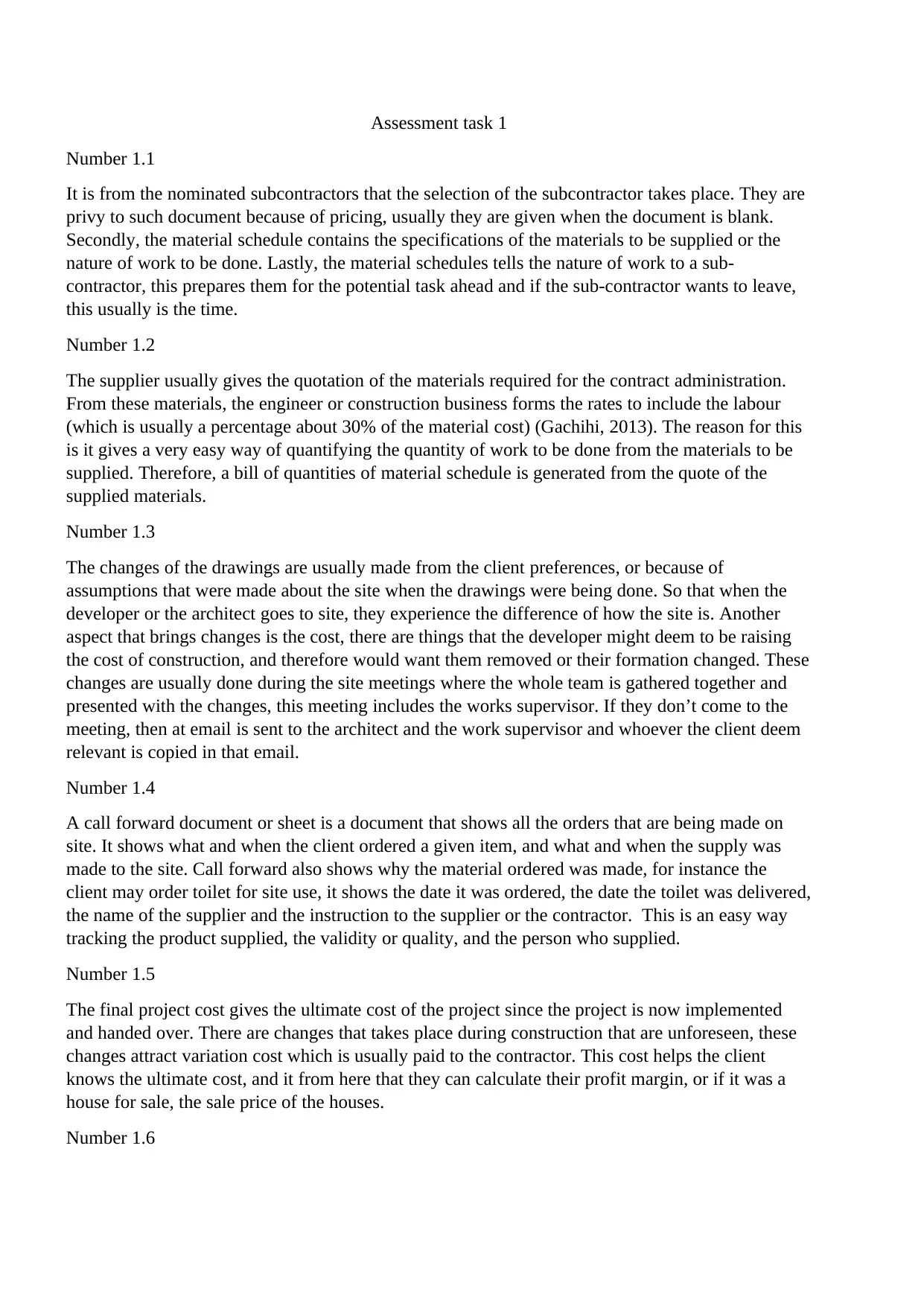
Assessment task 1
Number 1.1
It is from the nominated subcontractors that the selection of the subcontractor takes place. They are
privy to such document because of pricing, usually they are given when the document is blank.
Secondly, the material schedule contains the specifications of the materials to be supplied or the
nature of work to be done. Lastly, the material schedules tells the nature of work to a sub-
contractor, this prepares them for the potential task ahead and if the sub-contractor wants to leave,
this usually is the time.
Number 1.2
The supplier usually gives the quotation of the materials required for the contract administration.
From these materials, the engineer or construction business forms the rates to include the labour
(which is usually a percentage about 30% of the material cost) (Gachihi, 2013). The reason for this
is it gives a very easy way of quantifying the quantity of work to be done from the materials to be
supplied. Therefore, a bill of quantities of material schedule is generated from the quote of the
supplied materials.
Number 1.3
The changes of the drawings are usually made from the client preferences, or because of
assumptions that were made about the site when the drawings were being done. So that when the
developer or the architect goes to site, they experience the difference of how the site is. Another
aspect that brings changes is the cost, there are things that the developer might deem to be raising
the cost of construction, and therefore would want them removed or their formation changed. These
changes are usually done during the site meetings where the whole team is gathered together and
presented with the changes, this meeting includes the works supervisor. If they don’t come to the
meeting, then at email is sent to the architect and the work supervisor and whoever the client deem
relevant is copied in that email.
Number 1.4
A call forward document or sheet is a document that shows all the orders that are being made on
site. It shows what and when the client ordered a given item, and what and when the supply was
made to the site. Call forward also shows why the material ordered was made, for instance the
client may order toilet for site use, it shows the date it was ordered, the date the toilet was delivered,
the name of the supplier and the instruction to the supplier or the contractor. This is an easy way
tracking the product supplied, the validity or quality, and the person who supplied.
Number 1.5
The final project cost gives the ultimate cost of the project since the project is now implemented
and handed over. There are changes that takes place during construction that are unforeseen, these
changes attract variation cost which is usually paid to the contractor. This cost helps the client
knows the ultimate cost, and it from here that they can calculate their profit margin, or if it was a
house for sale, the sale price of the houses.
Number 1.6
Number 1.1
It is from the nominated subcontractors that the selection of the subcontractor takes place. They are
privy to such document because of pricing, usually they are given when the document is blank.
Secondly, the material schedule contains the specifications of the materials to be supplied or the
nature of work to be done. Lastly, the material schedules tells the nature of work to a sub-
contractor, this prepares them for the potential task ahead and if the sub-contractor wants to leave,
this usually is the time.
Number 1.2
The supplier usually gives the quotation of the materials required for the contract administration.
From these materials, the engineer or construction business forms the rates to include the labour
(which is usually a percentage about 30% of the material cost) (Gachihi, 2013). The reason for this
is it gives a very easy way of quantifying the quantity of work to be done from the materials to be
supplied. Therefore, a bill of quantities of material schedule is generated from the quote of the
supplied materials.
Number 1.3
The changes of the drawings are usually made from the client preferences, or because of
assumptions that were made about the site when the drawings were being done. So that when the
developer or the architect goes to site, they experience the difference of how the site is. Another
aspect that brings changes is the cost, there are things that the developer might deem to be raising
the cost of construction, and therefore would want them removed or their formation changed. These
changes are usually done during the site meetings where the whole team is gathered together and
presented with the changes, this meeting includes the works supervisor. If they don’t come to the
meeting, then at email is sent to the architect and the work supervisor and whoever the client deem
relevant is copied in that email.
Number 1.4
A call forward document or sheet is a document that shows all the orders that are being made on
site. It shows what and when the client ordered a given item, and what and when the supply was
made to the site. Call forward also shows why the material ordered was made, for instance the
client may order toilet for site use, it shows the date it was ordered, the date the toilet was delivered,
the name of the supplier and the instruction to the supplier or the contractor. This is an easy way
tracking the product supplied, the validity or quality, and the person who supplied.
Number 1.5
The final project cost gives the ultimate cost of the project since the project is now implemented
and handed over. There are changes that takes place during construction that are unforeseen, these
changes attract variation cost which is usually paid to the contractor. This cost helps the client
knows the ultimate cost, and it from here that they can calculate their profit margin, or if it was a
house for sale, the sale price of the houses.
Number 1.6
Paraphrase This Document
Need a fresh take? Get an instant paraphrase of this document with our AI Paraphraser
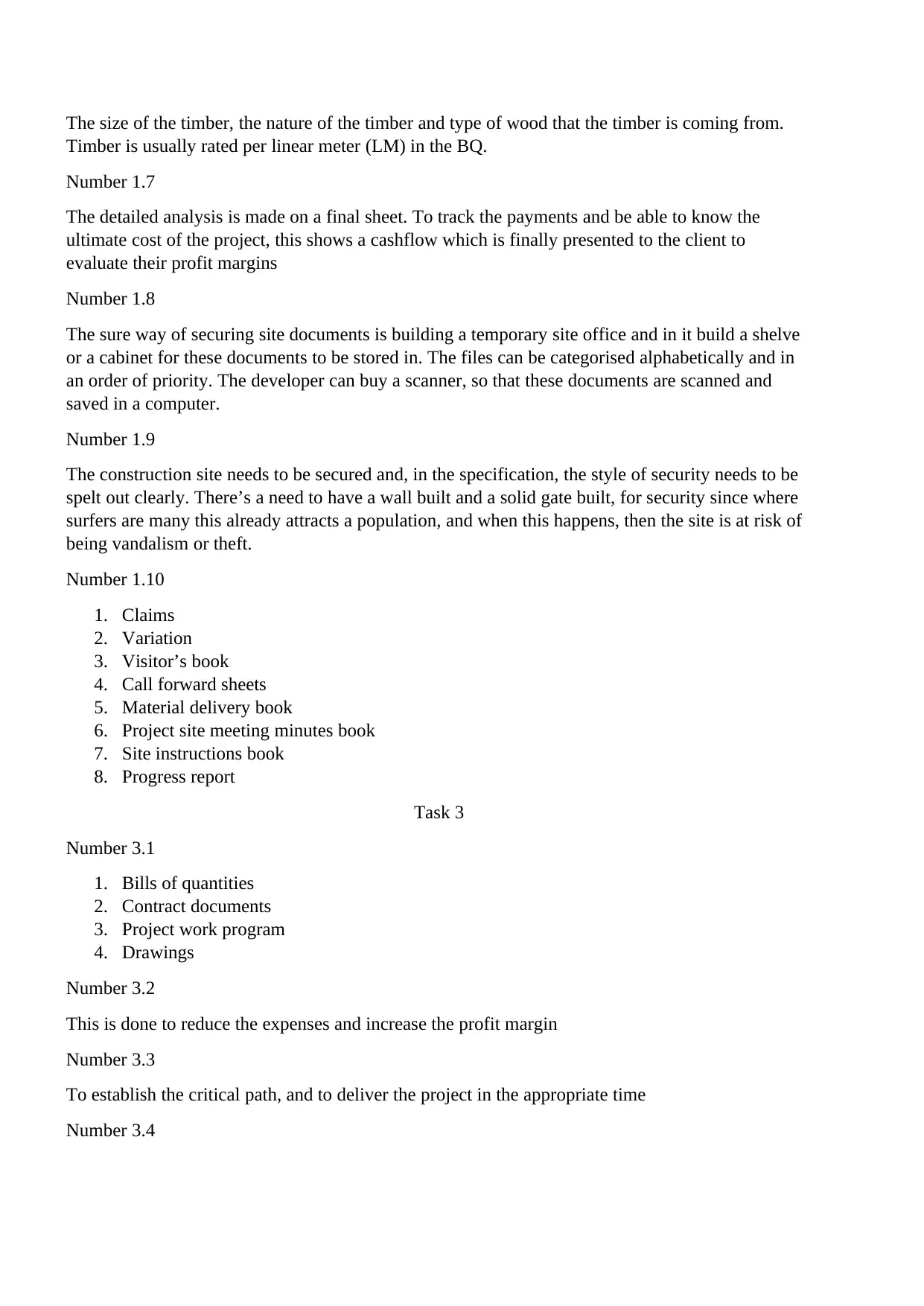
The size of the timber, the nature of the timber and type of wood that the timber is coming from.
Timber is usually rated per linear meter (LM) in the BQ.
Number 1.7
The detailed analysis is made on a final sheet. To track the payments and be able to know the
ultimate cost of the project, this shows a cashflow which is finally presented to the client to
evaluate their profit margins
Number 1.8
The sure way of securing site documents is building a temporary site office and in it build a shelve
or a cabinet for these documents to be stored in. The files can be categorised alphabetically and in
an order of priority. The developer can buy a scanner, so that these documents are scanned and
saved in a computer.
Number 1.9
The construction site needs to be secured and, in the specification, the style of security needs to be
spelt out clearly. There’s a need to have a wall built and a solid gate built, for security since where
surfers are many this already attracts a population, and when this happens, then the site is at risk of
being vandalism or theft.
Number 1.10
1. Claims
2. Variation
3. Visitor’s book
4. Call forward sheets
5. Material delivery book
6. Project site meeting minutes book
7. Site instructions book
8. Progress report
Task 3
Number 3.1
1. Bills of quantities
2. Contract documents
3. Project work program
4. Drawings
Number 3.2
This is done to reduce the expenses and increase the profit margin
Number 3.3
To establish the critical path, and to deliver the project in the appropriate time
Number 3.4
Timber is usually rated per linear meter (LM) in the BQ.
Number 1.7
The detailed analysis is made on a final sheet. To track the payments and be able to know the
ultimate cost of the project, this shows a cashflow which is finally presented to the client to
evaluate their profit margins
Number 1.8
The sure way of securing site documents is building a temporary site office and in it build a shelve
or a cabinet for these documents to be stored in. The files can be categorised alphabetically and in
an order of priority. The developer can buy a scanner, so that these documents are scanned and
saved in a computer.
Number 1.9
The construction site needs to be secured and, in the specification, the style of security needs to be
spelt out clearly. There’s a need to have a wall built and a solid gate built, for security since where
surfers are many this already attracts a population, and when this happens, then the site is at risk of
being vandalism or theft.
Number 1.10
1. Claims
2. Variation
3. Visitor’s book
4. Call forward sheets
5. Material delivery book
6. Project site meeting minutes book
7. Site instructions book
8. Progress report
Task 3
Number 3.1
1. Bills of quantities
2. Contract documents
3. Project work program
4. Drawings
Number 3.2
This is done to reduce the expenses and increase the profit margin
Number 3.3
To establish the critical path, and to deliver the project in the appropriate time
Number 3.4
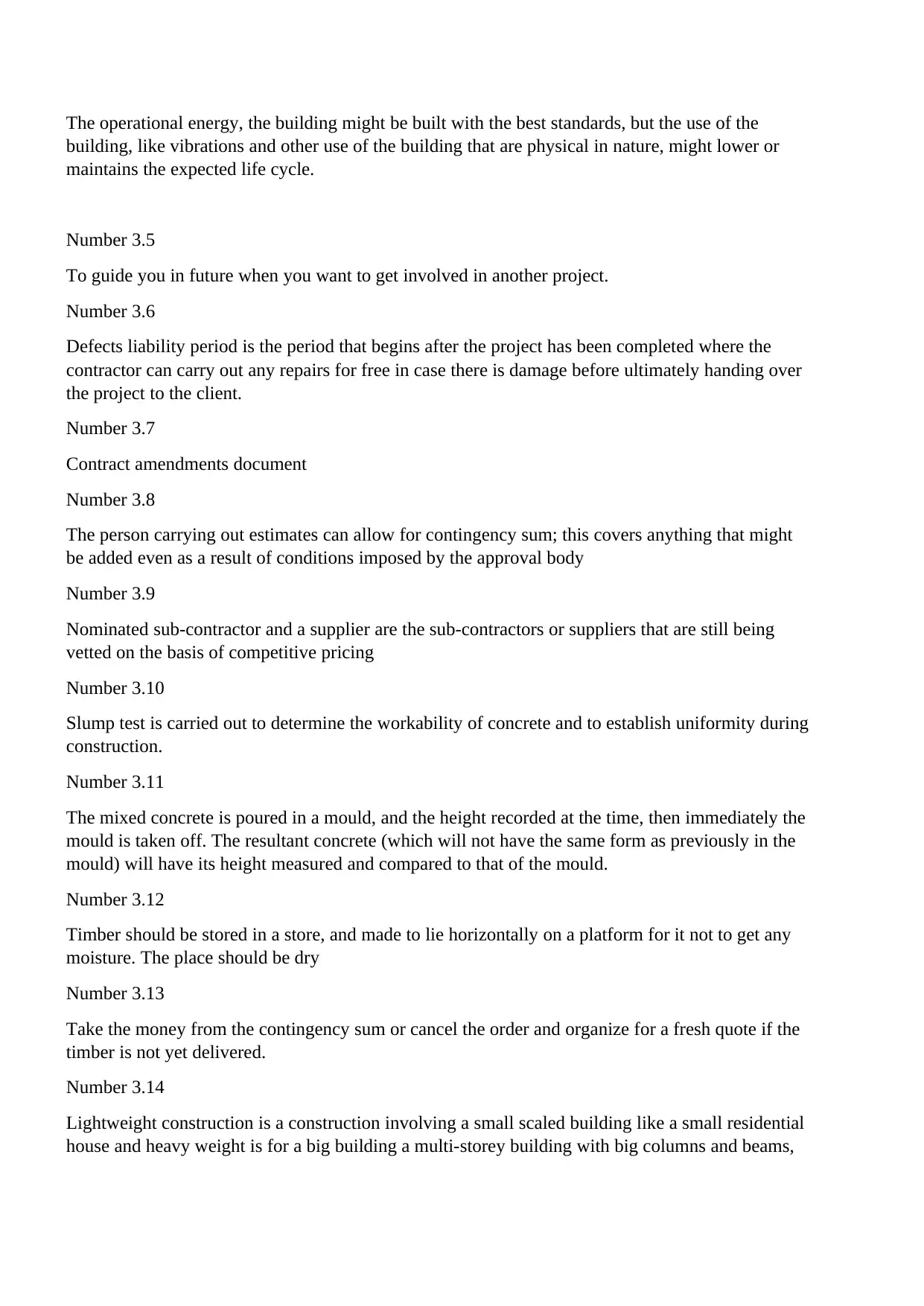
The operational energy, the building might be built with the best standards, but the use of the
building, like vibrations and other use of the building that are physical in nature, might lower or
maintains the expected life cycle.
Number 3.5
To guide you in future when you want to get involved in another project.
Number 3.6
Defects liability period is the period that begins after the project has been completed where the
contractor can carry out any repairs for free in case there is damage before ultimately handing over
the project to the client.
Number 3.7
Contract amendments document
Number 3.8
The person carrying out estimates can allow for contingency sum; this covers anything that might
be added even as a result of conditions imposed by the approval body
Number 3.9
Nominated sub-contractor and a supplier are the sub-contractors or suppliers that are still being
vetted on the basis of competitive pricing
Number 3.10
Slump test is carried out to determine the workability of concrete and to establish uniformity during
construction.
Number 3.11
The mixed concrete is poured in a mould, and the height recorded at the time, then immediately the
mould is taken off. The resultant concrete (which will not have the same form as previously in the
mould) will have its height measured and compared to that of the mould.
Number 3.12
Timber should be stored in a store, and made to lie horizontally on a platform for it not to get any
moisture. The place should be dry
Number 3.13
Take the money from the contingency sum or cancel the order and organize for a fresh quote if the
timber is not yet delivered.
Number 3.14
Lightweight construction is a construction involving a small scaled building like a small residential
house and heavy weight is for a big building a multi-storey building with big columns and beams,
building, like vibrations and other use of the building that are physical in nature, might lower or
maintains the expected life cycle.
Number 3.5
To guide you in future when you want to get involved in another project.
Number 3.6
Defects liability period is the period that begins after the project has been completed where the
contractor can carry out any repairs for free in case there is damage before ultimately handing over
the project to the client.
Number 3.7
Contract amendments document
Number 3.8
The person carrying out estimates can allow for contingency sum; this covers anything that might
be added even as a result of conditions imposed by the approval body
Number 3.9
Nominated sub-contractor and a supplier are the sub-contractors or suppliers that are still being
vetted on the basis of competitive pricing
Number 3.10
Slump test is carried out to determine the workability of concrete and to establish uniformity during
construction.
Number 3.11
The mixed concrete is poured in a mould, and the height recorded at the time, then immediately the
mould is taken off. The resultant concrete (which will not have the same form as previously in the
mould) will have its height measured and compared to that of the mould.
Number 3.12
Timber should be stored in a store, and made to lie horizontally on a platform for it not to get any
moisture. The place should be dry
Number 3.13
Take the money from the contingency sum or cancel the order and organize for a fresh quote if the
timber is not yet delivered.
Number 3.14
Lightweight construction is a construction involving a small scaled building like a small residential
house and heavy weight is for a big building a multi-storey building with big columns and beams,
⊘ This is a preview!⊘
Do you want full access?
Subscribe today to unlock all pages.

Trusted by 1+ million students worldwide
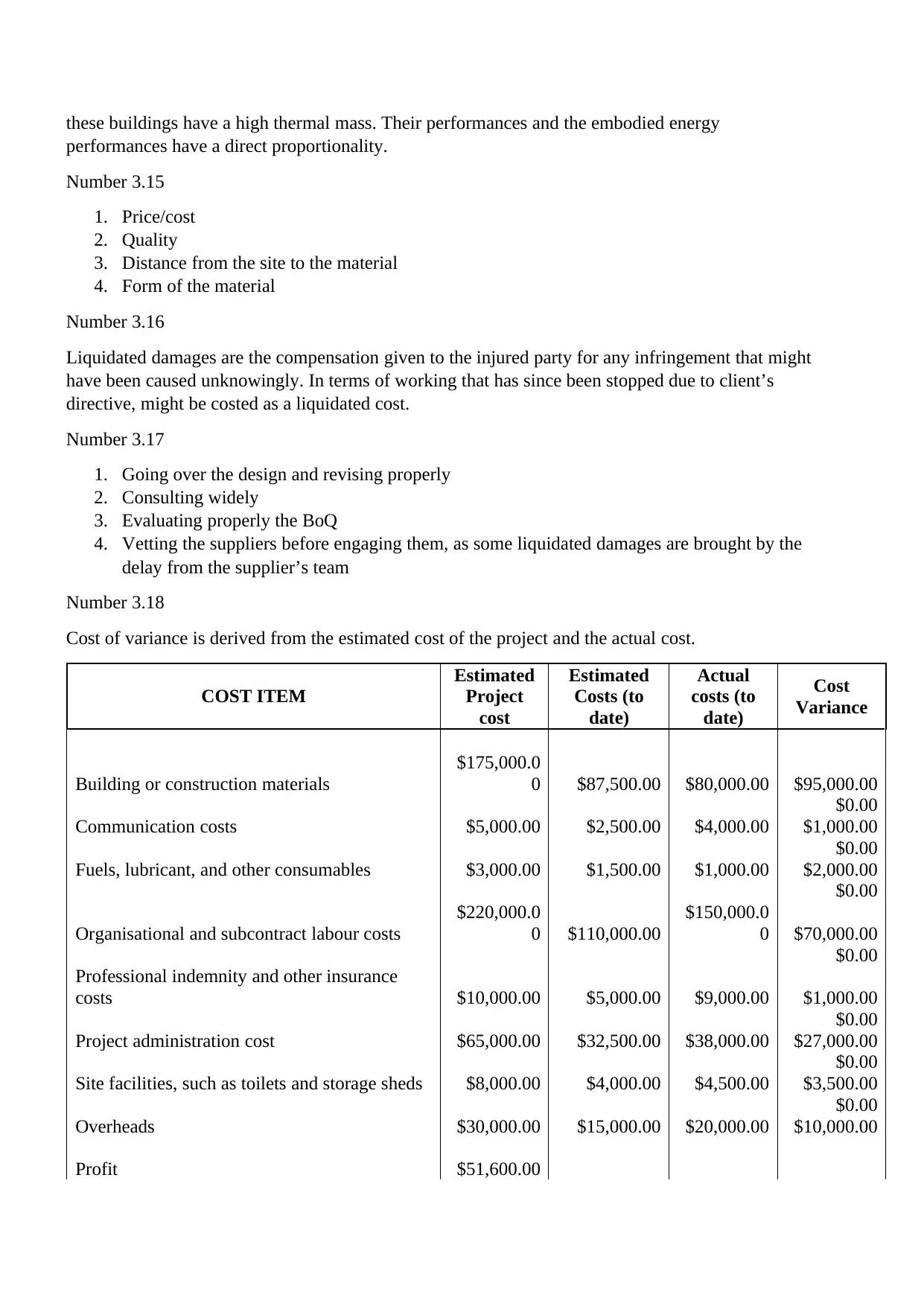
these buildings have a high thermal mass. Their performances and the embodied energy
performances have a direct proportionality.
Number 3.15
1. Price/cost
2. Quality
3. Distance from the site to the material
4. Form of the material
Number 3.16
Liquidated damages are the compensation given to the injured party for any infringement that might
have been caused unknowingly. In terms of working that has since been stopped due to client’s
directive, might be costed as a liquidated cost.
Number 3.17
1. Going over the design and revising properly
2. Consulting widely
3. Evaluating properly the BoQ
4. Vetting the suppliers before engaging them, as some liquidated damages are brought by the
delay from the supplier’s team
Number 3.18
Cost of variance is derived from the estimated cost of the project and the actual cost.
COST ITEM
Estimated
Project
cost
Estimated
Costs (to
date)
Actual
costs (to
date)
Cost
Variance
Building or construction materials
$175,000.0
0 $87,500.00 $80,000.00 $95,000.00
$0.00
Communication costs $5,000.00 $2,500.00 $4,000.00 $1,000.00
$0.00
Fuels, lubricant, and other consumables $3,000.00 $1,500.00 $1,000.00 $2,000.00
$0.00
Organisational and subcontract labour costs
$220,000.0
0 $110,000.00
$150,000.0
0 $70,000.00
$0.00
Professional indemnity and other insurance
costs $10,000.00 $5,000.00 $9,000.00 $1,000.00
$0.00
Project administration cost $65,000.00 $32,500.00 $38,000.00 $27,000.00
$0.00
Site facilities, such as toilets and storage sheds $8,000.00 $4,000.00 $4,500.00 $3,500.00
$0.00
Overheads $30,000.00 $15,000.00 $20,000.00 $10,000.00
Profit $51,600.00
performances have a direct proportionality.
Number 3.15
1. Price/cost
2. Quality
3. Distance from the site to the material
4. Form of the material
Number 3.16
Liquidated damages are the compensation given to the injured party for any infringement that might
have been caused unknowingly. In terms of working that has since been stopped due to client’s
directive, might be costed as a liquidated cost.
Number 3.17
1. Going over the design and revising properly
2. Consulting widely
3. Evaluating properly the BoQ
4. Vetting the suppliers before engaging them, as some liquidated damages are brought by the
delay from the supplier’s team
Number 3.18
Cost of variance is derived from the estimated cost of the project and the actual cost.
COST ITEM
Estimated
Project
cost
Estimated
Costs (to
date)
Actual
costs (to
date)
Cost
Variance
Building or construction materials
$175,000.0
0 $87,500.00 $80,000.00 $95,000.00
$0.00
Communication costs $5,000.00 $2,500.00 $4,000.00 $1,000.00
$0.00
Fuels, lubricant, and other consumables $3,000.00 $1,500.00 $1,000.00 $2,000.00
$0.00
Organisational and subcontract labour costs
$220,000.0
0 $110,000.00
$150,000.0
0 $70,000.00
$0.00
Professional indemnity and other insurance
costs $10,000.00 $5,000.00 $9,000.00 $1,000.00
$0.00
Project administration cost $65,000.00 $32,500.00 $38,000.00 $27,000.00
$0.00
Site facilities, such as toilets and storage sheds $8,000.00 $4,000.00 $4,500.00 $3,500.00
$0.00
Overheads $30,000.00 $15,000.00 $20,000.00 $10,000.00
Profit $51,600.00
Paraphrase This Document
Need a fresh take? Get an instant paraphrase of this document with our AI Paraphraser
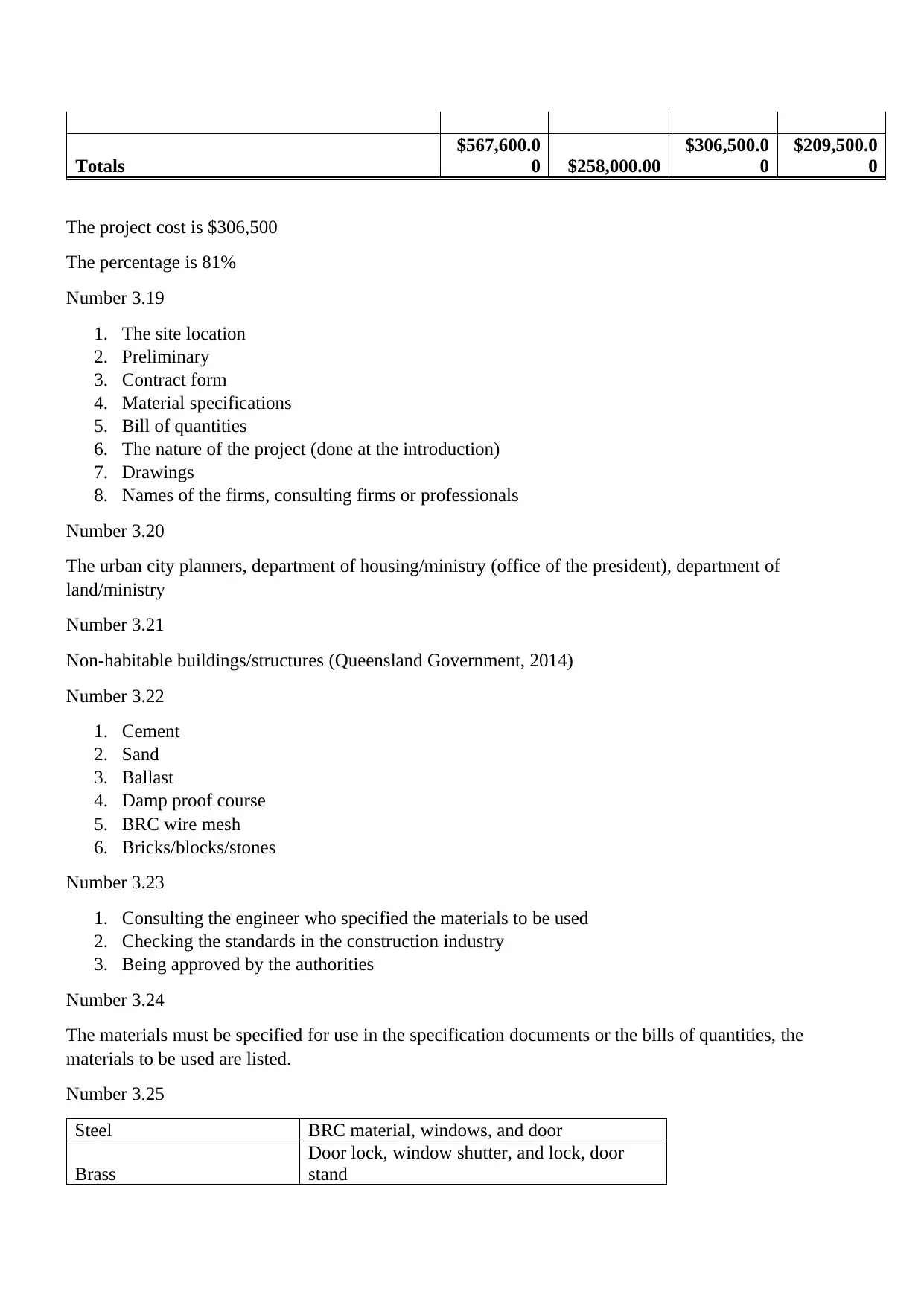
Totals
$567,600.0
0 $258,000.00
$306,500.0
0
$209,500.0
0
The project cost is $306,500
The percentage is 81%
Number 3.19
1. The site location
2. Preliminary
3. Contract form
4. Material specifications
5. Bill of quantities
6. The nature of the project (done at the introduction)
7. Drawings
8. Names of the firms, consulting firms or professionals
Number 3.20
The urban city planners, department of housing/ministry (office of the president), department of
land/ministry
Number 3.21
Non-habitable buildings/structures (Queensland Government, 2014)
Number 3.22
1. Cement
2. Sand
3. Ballast
4. Damp proof course
5. BRC wire mesh
6. Bricks/blocks/stones
Number 3.23
1. Consulting the engineer who specified the materials to be used
2. Checking the standards in the construction industry
3. Being approved by the authorities
Number 3.24
The materials must be specified for use in the specification documents or the bills of quantities, the
materials to be used are listed.
Number 3.25
Steel BRC material, windows, and door
Brass
Door lock, window shutter, and lock, door
stand
$567,600.0
0 $258,000.00
$306,500.0
0
$209,500.0
0
The project cost is $306,500
The percentage is 81%
Number 3.19
1. The site location
2. Preliminary
3. Contract form
4. Material specifications
5. Bill of quantities
6. The nature of the project (done at the introduction)
7. Drawings
8. Names of the firms, consulting firms or professionals
Number 3.20
The urban city planners, department of housing/ministry (office of the president), department of
land/ministry
Number 3.21
Non-habitable buildings/structures (Queensland Government, 2014)
Number 3.22
1. Cement
2. Sand
3. Ballast
4. Damp proof course
5. BRC wire mesh
6. Bricks/blocks/stones
Number 3.23
1. Consulting the engineer who specified the materials to be used
2. Checking the standards in the construction industry
3. Being approved by the authorities
Number 3.24
The materials must be specified for use in the specification documents or the bills of quantities, the
materials to be used are listed.
Number 3.25
Steel BRC material, windows, and door
Brass
Door lock, window shutter, and lock, door
stand
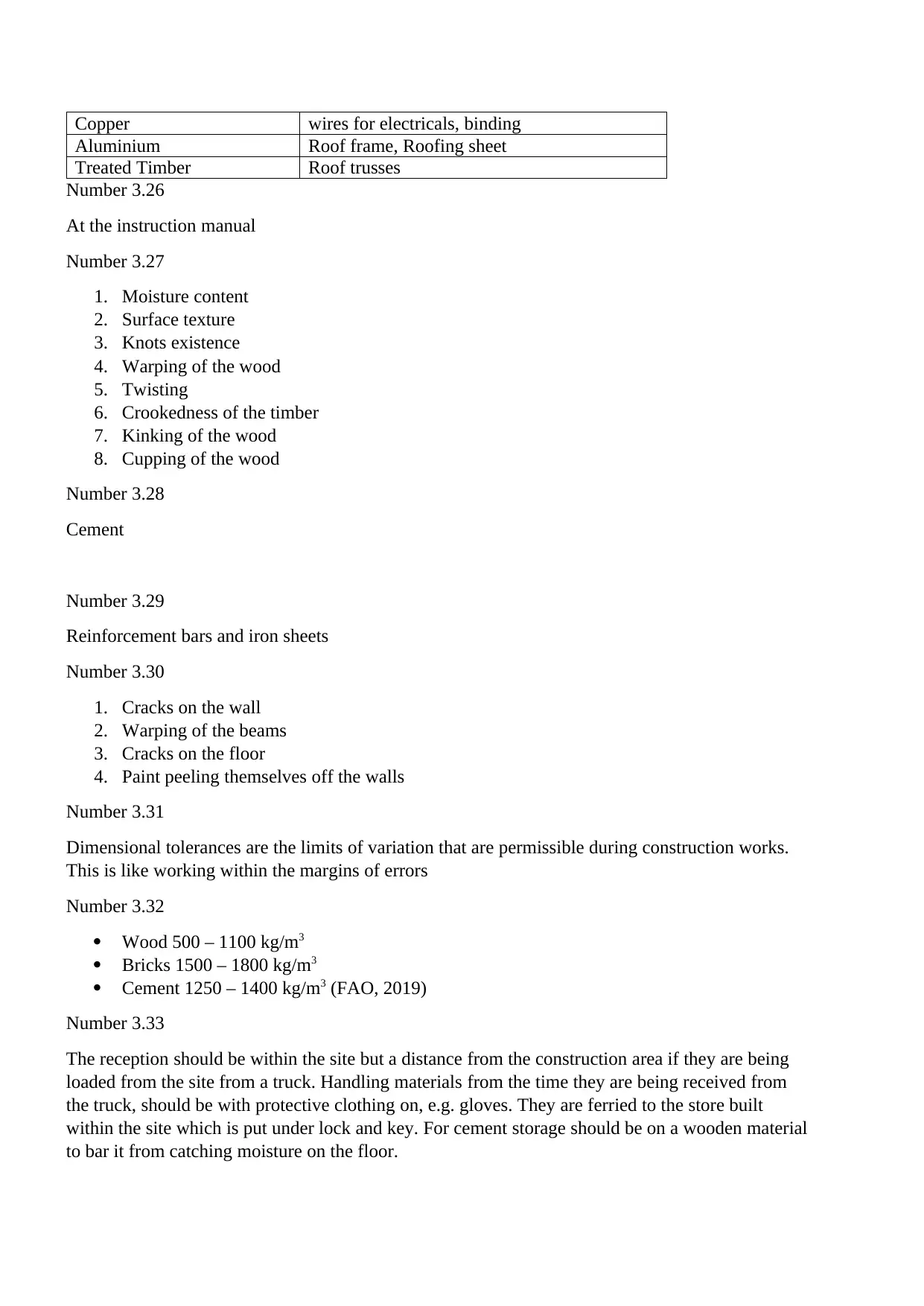
Copper wires for electricals, binding
Aluminium Roof frame, Roofing sheet
Treated Timber Roof trusses
Number 3.26
At the instruction manual
Number 3.27
1. Moisture content
2. Surface texture
3. Knots existence
4. Warping of the wood
5. Twisting
6. Crookedness of the timber
7. Kinking of the wood
8. Cupping of the wood
Number 3.28
Cement
Number 3.29
Reinforcement bars and iron sheets
Number 3.30
1. Cracks on the wall
2. Warping of the beams
3. Cracks on the floor
4. Paint peeling themselves off the walls
Number 3.31
Dimensional tolerances are the limits of variation that are permissible during construction works.
This is like working within the margins of errors
Number 3.32
Wood 500 – 1100 kg/m3
Bricks 1500 – 1800 kg/m3
Cement 1250 – 1400 kg/m3 (FAO, 2019)
Number 3.33
The reception should be within the site but a distance from the construction area if they are being
loaded from the site from a truck. Handling materials from the time they are being received from
the truck, should be with protective clothing on, e.g. gloves. They are ferried to the store built
within the site which is put under lock and key. For cement storage should be on a wooden material
to bar it from catching moisture on the floor.
Aluminium Roof frame, Roofing sheet
Treated Timber Roof trusses
Number 3.26
At the instruction manual
Number 3.27
1. Moisture content
2. Surface texture
3. Knots existence
4. Warping of the wood
5. Twisting
6. Crookedness of the timber
7. Kinking of the wood
8. Cupping of the wood
Number 3.28
Cement
Number 3.29
Reinforcement bars and iron sheets
Number 3.30
1. Cracks on the wall
2. Warping of the beams
3. Cracks on the floor
4. Paint peeling themselves off the walls
Number 3.31
Dimensional tolerances are the limits of variation that are permissible during construction works.
This is like working within the margins of errors
Number 3.32
Wood 500 – 1100 kg/m3
Bricks 1500 – 1800 kg/m3
Cement 1250 – 1400 kg/m3 (FAO, 2019)
Number 3.33
The reception should be within the site but a distance from the construction area if they are being
loaded from the site from a truck. Handling materials from the time they are being received from
the truck, should be with protective clothing on, e.g. gloves. They are ferried to the store built
within the site which is put under lock and key. For cement storage should be on a wooden material
to bar it from catching moisture on the floor.
⊘ This is a preview!⊘
Do you want full access?
Subscribe today to unlock all pages.

Trusted by 1+ million students worldwide

Task 4
Number 4.1
1. Drawings
2. Specifications
3. Information of the property
4. Bills of quantities
5. Insurances
Number 4.2
Number 4.3
Number 4.4
Number 4.5
These are done in the spreadsheet
Number 4.6
a. Acoustic Coatings like Mass loaded Vinyl (MLV) can be used in sound proofing,
Trademark sound proofing can be the best suppliers (Trademark Soundproofing, 2019)
b. The chosen experts are the Resonics and KFI studios, mechanical engineering and
architectural firms respectively. They both generally agree that the sound proofing material
is superb, and that it reduces the transmission of airborne noise. The advice was that this
product meets the physical and performance requirement for the acoustical application.
Number 4.1
1. Drawings
2. Specifications
3. Information of the property
4. Bills of quantities
5. Insurances
Number 4.2
Number 4.3
Number 4.4
Number 4.5
These are done in the spreadsheet
Number 4.6
a. Acoustic Coatings like Mass loaded Vinyl (MLV) can be used in sound proofing,
Trademark sound proofing can be the best suppliers (Trademark Soundproofing, 2019)
b. The chosen experts are the Resonics and KFI studios, mechanical engineering and
architectural firms respectively. They both generally agree that the sound proofing material
is superb, and that it reduces the transmission of airborne noise. The advice was that this
product meets the physical and performance requirement for the acoustical application.
Paraphrase This Document
Need a fresh take? Get an instant paraphrase of this document with our AI Paraphraser

Additionally, they advised that this system would work perfectly even in places where
vibration is.
Number 4.7
The pricing is appropriate because the total becomes to $70 per square meter which is very cheap
compared to the one attached above. This will be sufficient to cover what is required.
Number 4.8 – 4.10 (All have been answered in the spread sheet)
Task 5
Number 5.1 (Slab on Ground)
5.1.1
Blocks/bricks to anchor the poured slab
BRC to increase stability of the slab
DPC to prevent moisture from rising
Concrete is the slab itself (sand, Cement, and ballast)
Water, for making up the concrete
5.1.2
Water can be stored in tanks, built or plastic tanks,
cement delivered by trucks and stored in a store and raised by wooden platform
Sand will be delivered by trucks as well and stored in a closed place, so that it is not rained on
The rest of the materials are also stored, in the available store, enclosed as well
5.1.3
Concreting skills
Building and construction studies (certificate or Diploma)
Electrical and mechanical engineering skills
Machine operating
5.1.4
It would make them weak and not stable, and this can make the building collapse.
5.1.5
Slump test
Water absorption test
vibration is.
Number 4.7
The pricing is appropriate because the total becomes to $70 per square meter which is very cheap
compared to the one attached above. This will be sufficient to cover what is required.
Number 4.8 – 4.10 (All have been answered in the spread sheet)
Task 5
Number 5.1 (Slab on Ground)
5.1.1
Blocks/bricks to anchor the poured slab
BRC to increase stability of the slab
DPC to prevent moisture from rising
Concrete is the slab itself (sand, Cement, and ballast)
Water, for making up the concrete
5.1.2
Water can be stored in tanks, built or plastic tanks,
cement delivered by trucks and stored in a store and raised by wooden platform
Sand will be delivered by trucks as well and stored in a closed place, so that it is not rained on
The rest of the materials are also stored, in the available store, enclosed as well
5.1.3
Concreting skills
Building and construction studies (certificate or Diploma)
Electrical and mechanical engineering skills
Machine operating
5.1.4
It would make them weak and not stable, and this can make the building collapse.
5.1.5
Slump test
Water absorption test
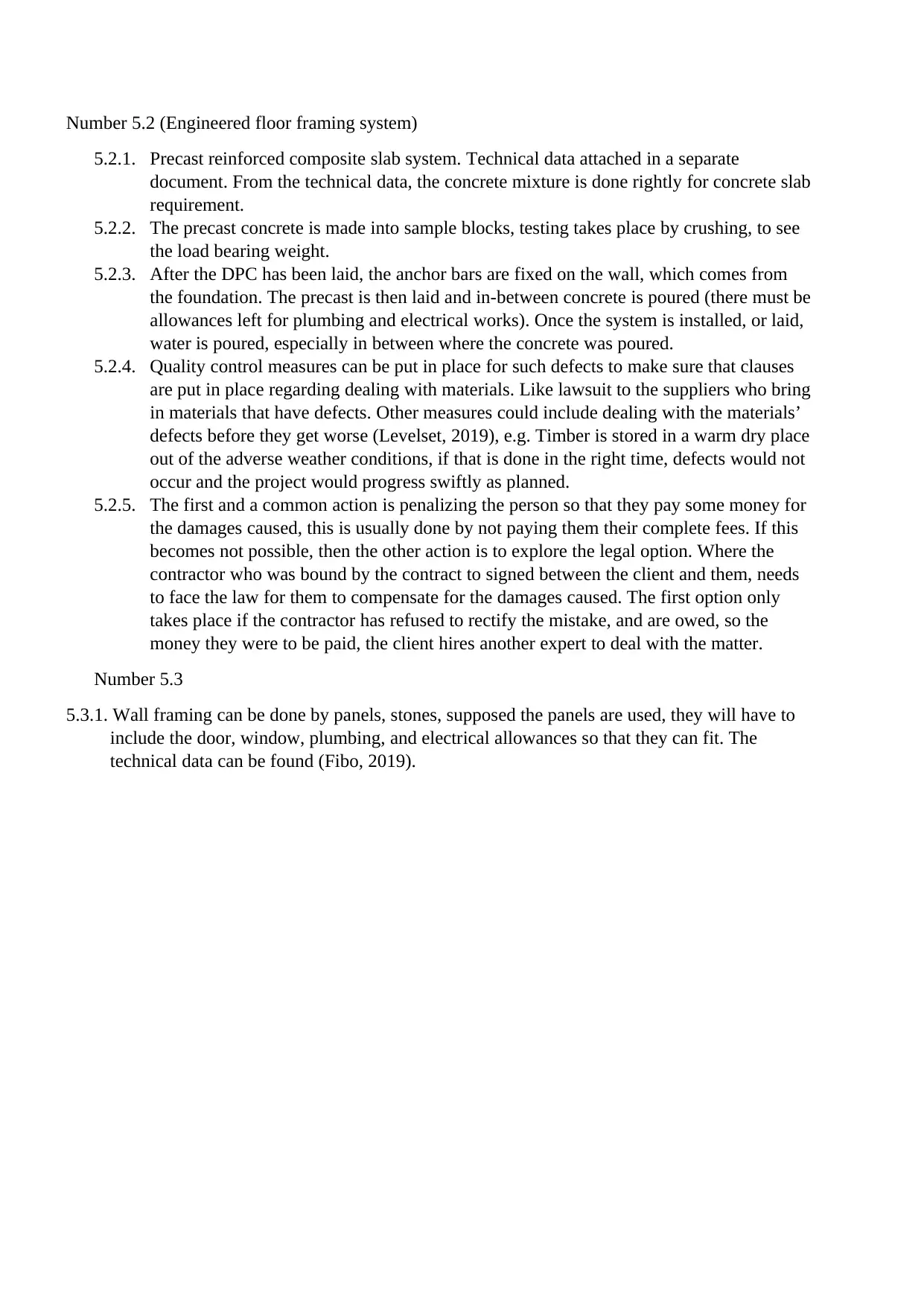
Number 5.2 (Engineered floor framing system)
5.2.1. Precast reinforced composite slab system. Technical data attached in a separate
document. From the technical data, the concrete mixture is done rightly for concrete slab
requirement.
5.2.2. The precast concrete is made into sample blocks, testing takes place by crushing, to see
the load bearing weight.
5.2.3. After the DPC has been laid, the anchor bars are fixed on the wall, which comes from
the foundation. The precast is then laid and in-between concrete is poured (there must be
allowances left for plumbing and electrical works). Once the system is installed, or laid,
water is poured, especially in between where the concrete was poured.
5.2.4. Quality control measures can be put in place for such defects to make sure that clauses
are put in place regarding dealing with materials. Like lawsuit to the suppliers who bring
in materials that have defects. Other measures could include dealing with the materials’
defects before they get worse (Levelset, 2019), e.g. Timber is stored in a warm dry place
out of the adverse weather conditions, if that is done in the right time, defects would not
occur and the project would progress swiftly as planned.
5.2.5. The first and a common action is penalizing the person so that they pay some money for
the damages caused, this is usually done by not paying them their complete fees. If this
becomes not possible, then the other action is to explore the legal option. Where the
contractor who was bound by the contract to signed between the client and them, needs
to face the law for them to compensate for the damages caused. The first option only
takes place if the contractor has refused to rectify the mistake, and are owed, so the
money they were to be paid, the client hires another expert to deal with the matter.
Number 5.3
5.3.1. Wall framing can be done by panels, stones, supposed the panels are used, they will have to
include the door, window, plumbing, and electrical allowances so that they can fit. The
technical data can be found (Fibo, 2019).
5.2.1. Precast reinforced composite slab system. Technical data attached in a separate
document. From the technical data, the concrete mixture is done rightly for concrete slab
requirement.
5.2.2. The precast concrete is made into sample blocks, testing takes place by crushing, to see
the load bearing weight.
5.2.3. After the DPC has been laid, the anchor bars are fixed on the wall, which comes from
the foundation. The precast is then laid and in-between concrete is poured (there must be
allowances left for plumbing and electrical works). Once the system is installed, or laid,
water is poured, especially in between where the concrete was poured.
5.2.4. Quality control measures can be put in place for such defects to make sure that clauses
are put in place regarding dealing with materials. Like lawsuit to the suppliers who bring
in materials that have defects. Other measures could include dealing with the materials’
defects before they get worse (Levelset, 2019), e.g. Timber is stored in a warm dry place
out of the adverse weather conditions, if that is done in the right time, defects would not
occur and the project would progress swiftly as planned.
5.2.5. The first and a common action is penalizing the person so that they pay some money for
the damages caused, this is usually done by not paying them their complete fees. If this
becomes not possible, then the other action is to explore the legal option. Where the
contractor who was bound by the contract to signed between the client and them, needs
to face the law for them to compensate for the damages caused. The first option only
takes place if the contractor has refused to rectify the mistake, and are owed, so the
money they were to be paid, the client hires another expert to deal with the matter.
Number 5.3
5.3.1. Wall framing can be done by panels, stones, supposed the panels are used, they will have to
include the door, window, plumbing, and electrical allowances so that they can fit. The
technical data can be found (Fibo, 2019).
⊘ This is a preview!⊘
Do you want full access?
Subscribe today to unlock all pages.

Trusted by 1+ million students worldwide
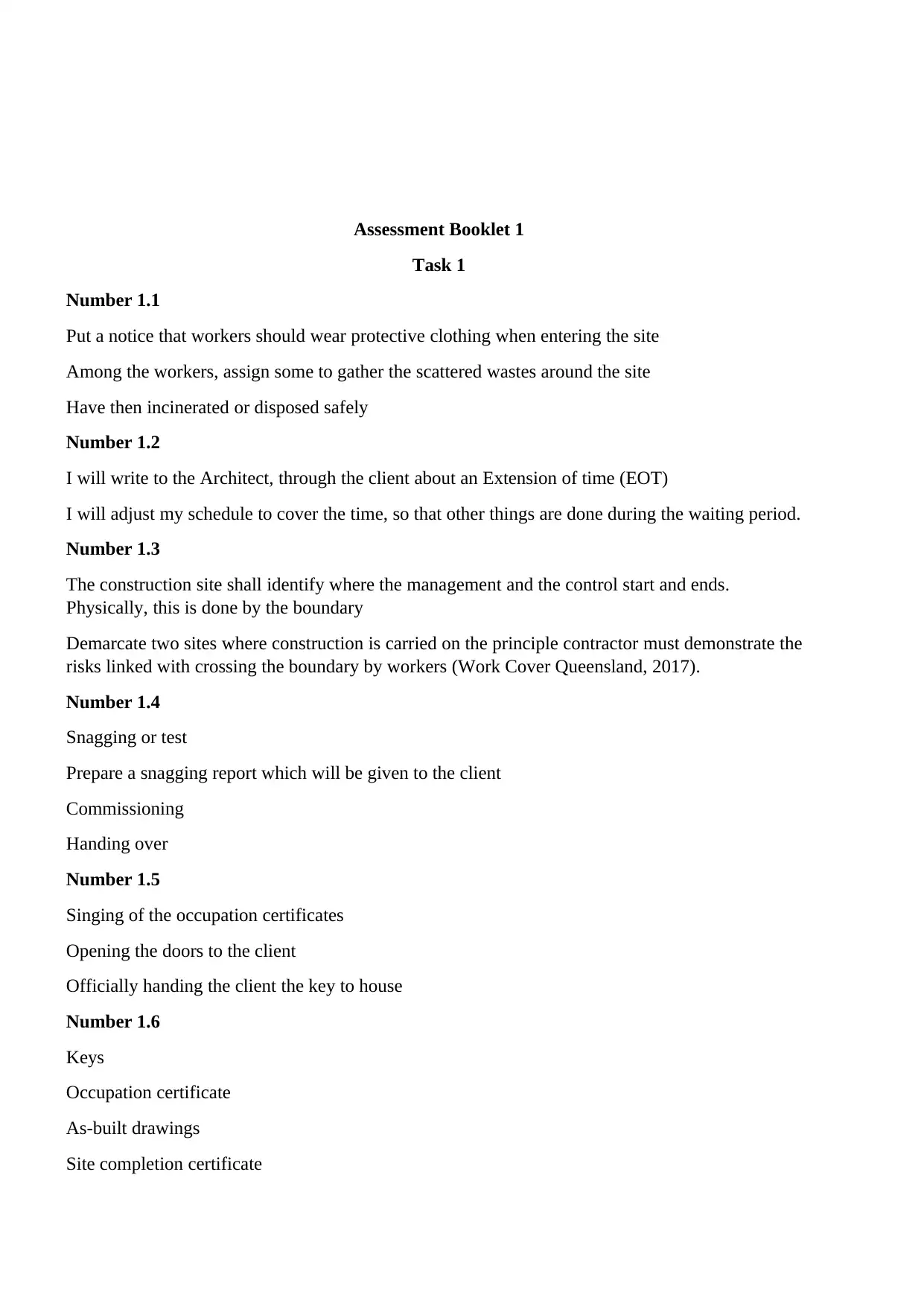
Assessment Booklet 1
Task 1
Number 1.1
Put a notice that workers should wear protective clothing when entering the site
Among the workers, assign some to gather the scattered wastes around the site
Have then incinerated or disposed safely
Number 1.2
I will write to the Architect, through the client about an Extension of time (EOT)
I will adjust my schedule to cover the time, so that other things are done during the waiting period.
Number 1.3
The construction site shall identify where the management and the control start and ends.
Physically, this is done by the boundary
Demarcate two sites where construction is carried on the principle contractor must demonstrate the
risks linked with crossing the boundary by workers (Work Cover Queensland, 2017).
Number 1.4
Snagging or test
Prepare a snagging report which will be given to the client
Commissioning
Handing over
Number 1.5
Singing of the occupation certificates
Opening the doors to the client
Officially handing the client the key to house
Number 1.6
Keys
Occupation certificate
As-built drawings
Site completion certificate
Task 1
Number 1.1
Put a notice that workers should wear protective clothing when entering the site
Among the workers, assign some to gather the scattered wastes around the site
Have then incinerated or disposed safely
Number 1.2
I will write to the Architect, through the client about an Extension of time (EOT)
I will adjust my schedule to cover the time, so that other things are done during the waiting period.
Number 1.3
The construction site shall identify where the management and the control start and ends.
Physically, this is done by the boundary
Demarcate two sites where construction is carried on the principle contractor must demonstrate the
risks linked with crossing the boundary by workers (Work Cover Queensland, 2017).
Number 1.4
Snagging or test
Prepare a snagging report which will be given to the client
Commissioning
Handing over
Number 1.5
Singing of the occupation certificates
Opening the doors to the client
Officially handing the client the key to house
Number 1.6
Keys
Occupation certificate
As-built drawings
Site completion certificate
Paraphrase This Document
Need a fresh take? Get an instant paraphrase of this document with our AI Paraphraser
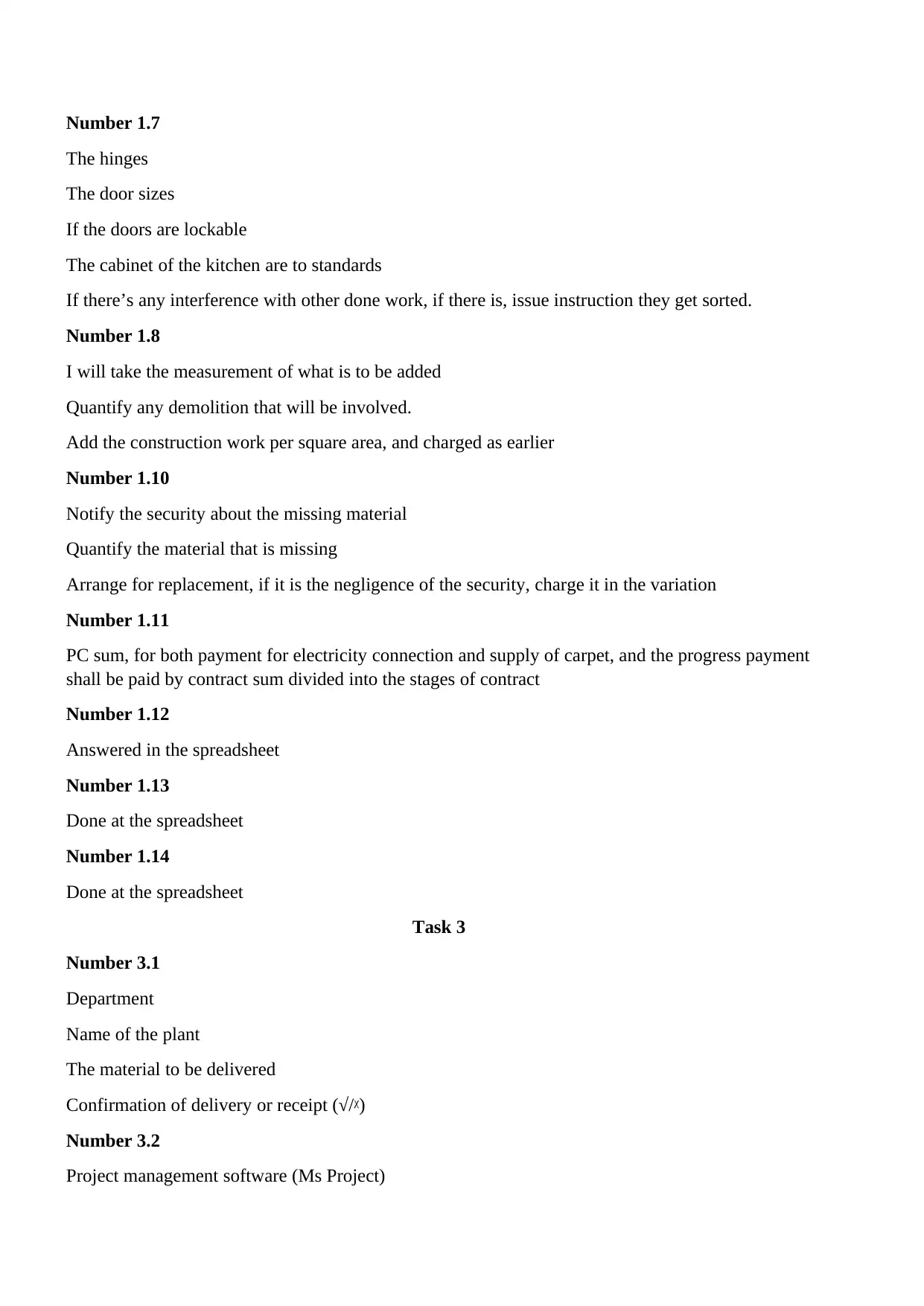
Number 1.7
The hinges
The door sizes
If the doors are lockable
The cabinet of the kitchen are to standards
If there’s any interference with other done work, if there is, issue instruction they get sorted.
Number 1.8
I will take the measurement of what is to be added
Quantify any demolition that will be involved.
Add the construction work per square area, and charged as earlier
Number 1.10
Notify the security about the missing material
Quantify the material that is missing
Arrange for replacement, if it is the negligence of the security, charge it in the variation
Number 1.11
PC sum, for both payment for electricity connection and supply of carpet, and the progress payment
shall be paid by contract sum divided into the stages of contract
Number 1.12
Answered in the spreadsheet
Number 1.13
Done at the spreadsheet
Number 1.14
Done at the spreadsheet
Task 3
Number 3.1
Department
Name of the plant
The material to be delivered
Confirmation of delivery or receipt (√/ᵡ)
Number 3.2
Project management software (Ms Project)
The hinges
The door sizes
If the doors are lockable
The cabinet of the kitchen are to standards
If there’s any interference with other done work, if there is, issue instruction they get sorted.
Number 1.8
I will take the measurement of what is to be added
Quantify any demolition that will be involved.
Add the construction work per square area, and charged as earlier
Number 1.10
Notify the security about the missing material
Quantify the material that is missing
Arrange for replacement, if it is the negligence of the security, charge it in the variation
Number 1.11
PC sum, for both payment for electricity connection and supply of carpet, and the progress payment
shall be paid by contract sum divided into the stages of contract
Number 1.12
Answered in the spreadsheet
Number 1.13
Done at the spreadsheet
Number 1.14
Done at the spreadsheet
Task 3
Number 3.1
Department
Name of the plant
The material to be delivered
Confirmation of delivery or receipt (√/ᵡ)
Number 3.2
Project management software (Ms Project)

RevitMEP
Autodesk 360
Number 3.3
Contract management guide
The contract documents
Specification made by the site engineer
Number 3.4
After the DLP, the client has no obligation on the contractor and must seek redress in case of any
damages, breach of contract, and any negligence. So, the contract may be reviewed to check if
there’s anything that was missing or wasn’t addressed by the contractor.
Number 3.5
Act, work health and safety act 2011
Regulation, work health and safety regulation 2011
Codes, ACT codes of practice
Regulation, workSafe act
And other acts like, the work safe in the workplace -general work health and safety
Number 3.6
By going through the preliminary requirements
Going by the standards and acts which spell out the temporary equipment required for the project
Number 3.7
Writing an email to them and attaching the approval certificates for the construction of the site,
issuing them or showing them the insurance certificate (which must be acquired in case of any
damages of the neighbouring building). These must be signed by the supervisor or the client and the
owner of the building neighbouring the site.
Number 3.8
Assessing the damages caused
Taking the audit in terms of costing
Termination of contract with compensation strategies made, for the damages caused.
Number 3.9
Through the contract documents, it is spelt out what the contractor was involved in in terms of
labour. Those items would be listed so that should there be any defect on those items, then the
client has the obligation to ask the contractor to attend to those items. The complaint would be
lodged through the site engineer for the site items to be fixed. The process is informing the
Autodesk 360
Number 3.3
Contract management guide
The contract documents
Specification made by the site engineer
Number 3.4
After the DLP, the client has no obligation on the contractor and must seek redress in case of any
damages, breach of contract, and any negligence. So, the contract may be reviewed to check if
there’s anything that was missing or wasn’t addressed by the contractor.
Number 3.5
Act, work health and safety act 2011
Regulation, work health and safety regulation 2011
Codes, ACT codes of practice
Regulation, workSafe act
And other acts like, the work safe in the workplace -general work health and safety
Number 3.6
By going through the preliminary requirements
Going by the standards and acts which spell out the temporary equipment required for the project
Number 3.7
Writing an email to them and attaching the approval certificates for the construction of the site,
issuing them or showing them the insurance certificate (which must be acquired in case of any
damages of the neighbouring building). These must be signed by the supervisor or the client and the
owner of the building neighbouring the site.
Number 3.8
Assessing the damages caused
Taking the audit in terms of costing
Termination of contract with compensation strategies made, for the damages caused.
Number 3.9
Through the contract documents, it is spelt out what the contractor was involved in in terms of
labour. Those items would be listed so that should there be any defect on those items, then the
client has the obligation to ask the contractor to attend to those items. The complaint would be
lodged through the site engineer for the site items to be fixed. The process is informing the
⊘ This is a preview!⊘
Do you want full access?
Subscribe today to unlock all pages.

Trusted by 1+ million students worldwide
1 out of 16
Related Documents
Your All-in-One AI-Powered Toolkit for Academic Success.
+13062052269
info@desklib.com
Available 24*7 on WhatsApp / Email
![[object Object]](/_next/static/media/star-bottom.7253800d.svg)
Unlock your academic potential
Copyright © 2020–2025 A2Z Services. All Rights Reserved. Developed and managed by ZUCOL.





